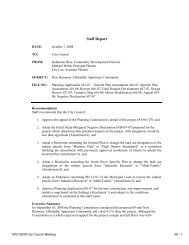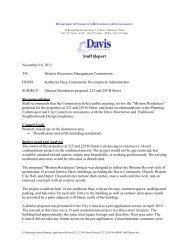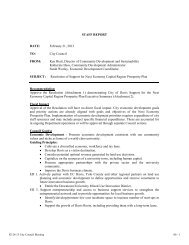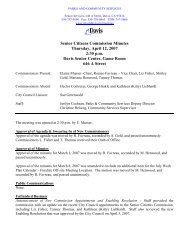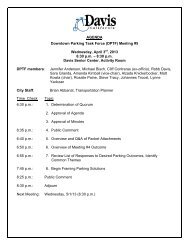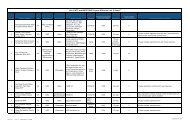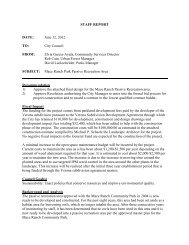10 Draft Integrated Waste Management Plan - City Council - City of ...
10 Draft Integrated Waste Management Plan - City Council - City of ...
10 Draft Integrated Waste Management Plan - City Council - City of ...
You also want an ePaper? Increase the reach of your titles
YUMPU automatically turns print PDFs into web optimized ePapers that Google loves.
2012 Davis <strong>Integrated</strong> <strong>Waste</strong> <strong>Management</strong> <strong>Plan</strong><br />
NRC November meeting more, so that when staff presents the Annual Report to the NRC, more members <strong>of</strong> the<br />
community can be there to listen to the status updates and provide comment.<br />
Staff could also hold an annual briefing to the business community as well. Every year, the <strong>City</strong> could meet<br />
with the Davis Chamber <strong>of</strong> Commerce or the Davis Downtown Business Association. During these meetings,<br />
staff can present the current and projected projects and gather feedback about current services and programs.<br />
7 Regulation and Policy<br />
7.1<br />
Existing Regulation and Policy<br />
7.1.1 Diversion Requirements<br />
In 1989, the <strong>Integrated</strong> <strong>Waste</strong> <strong>Management</strong> Act (AB 939) was passed and enacted Public Resources Code<br />
(PRC) section 41780, which required a 25% reduction <strong>of</strong> solid waste disposal by cities and counties by 1995<br />
and 50% by 2000. The planning requisites in this section require waste diversion from landfill or transformation<br />
facilities through source reduction, recycling, and composting activities identified in city, county and regional<br />
agency Source Reduction and Recycling Elements (SRRE).<br />
Under AB 939, diversion was calculated from a base year, where the State calculated: 1) how much waste was<br />
prevented (waste prevention), 2) how much waste was recycled and composted; and 3) how much waste was<br />
disposed. The total <strong>of</strong> these three activities was considered the total waste generated. The total materials<br />
prevented, recycled and composted were considered diverted and the tons landfilled were not diverted. This was<br />
the process that was used to determine whether the <strong>City</strong> achieved the 50% diversion mandate.<br />
The <strong>City</strong> easily met the 1995 goal <strong>of</strong> 25% diversion, but meeting the 2000 goal was not as easy. In addition to<br />
the base year problems noted above, in 2000, California’s waste reporting system was based on estimates <strong>of</strong><br />
population, employment and taxable sales, not on the amount <strong>of</strong> trash disposed. Due to a surging economy,<br />
high levels <strong>of</strong> business activity and construction, achieving a 50% diversion rate was more difficult for Davis.<br />
Diversion rates did not include the tons <strong>of</strong> yard materials that were collected each week for composting by<br />
DWR—the State’s calculations did not consider these materials “diverted” using their reporting procedures. The<br />
<strong>City</strong> did achieve the State-calculated 50% diversion in 2001.<br />
DRAFT<br />
In 2007, SB <strong>10</strong>16 was passed, changing the way the State measured waste diversion. The goal <strong>of</strong> the new per<br />
capita disposal measurement system was to make the AB 939 process <strong>of</strong> goal measurement simpler, timelier,<br />
and more accurate. SB <strong>10</strong>16 changed to a disposal-based indicator—the per capita disposal rate—which uses<br />
only two factors: a jurisdiction's population (or in some cases employment) and its disposal as reported by<br />
disposal facilities. The AB 939 50% solid waste disposal reduction requirement is now measured in terms <strong>of</strong><br />
per-capita disposal expressed as pounds <strong>of</strong> waste generated per person per day, or pounds per employee per day.<br />
The focus is on program implementation, actual recycling, and other diversion programs instead <strong>of</strong> estimated<br />
numbers.<br />
Page | 7-51



